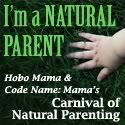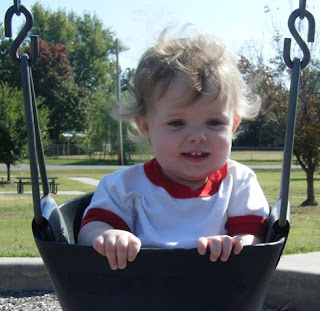Wednesday, October 27, 2010
Sunday, October 24, 2010
Get started baby signing: A review of Baby Sign Language for Hearing Babies

Guest post by Jorje Axline
I remember hearing about baby sign language when my middle child was already communicating pretty well. It sounded cool, but I wasn't sure if I would really dedicate the time to it and it seemed a bit late anyway. Well now I have a two-month-old and pretty much as soon as I brought her home, I picked out and requested a book from my local library about baby signing. I chose Baby Sign Language for Hearing Babies

Haven't heard of baby signing?...especially not for hearing babies? The idea is that babies can communicate with you well before they are able to speak, especially before they are able to speak clearly! That doesn't sound so far-fetched, does it? Toddlers are famous for pointing at things, and who hasn't seen a baby raise their arms to an adult, the international sign for "Pick me up!"
The book is small enough (146 pages, including a picture dictionary), and the chapters are short, so they are separated pretty well into bite-sized bits. If you are a bathroom reader, this book would work well for that kind of reading. It is absolutely riddled with little anecdotes sent in by parents who have used the methods in the book. So if you don't like that style...well, at least you can skip those bits. They are clearly marked. Interestingly, all of the anecdotes come from New Zealand, including ones from the author and her husband. It seemed odd to me to have anecdotes added in by the actual author of the book. I mean...wouldn't that go into the content?
All right, before I rattle too much, I really wanted to go through the book in chapters for you:
- Chapter 1 - This chapter tells you about the "Baby Talk Program," explaining what baby signing actually is. It also provides lots of researchy stuff on why YOU should try this! You can see the Table of Contents and read the entire first chapter of the book at Google Books.
- Chapter 2 - tells you the benefits and explains that signing babies actually talk earlier than other babies! So this is kind of more selling you on the idea, including a FAQ section. I think the biggest selling point presented here is that if you teach your baby to sign, to communicate with you, you set her up for less frustration. Sure, a toddler can point, but it often takes several guesses to figure out what they want. Other examples are given, of course.
- Chapter 3 - This is where I am right now. My darling Sasha is just now two months old. She hasn't even quite figured out that she has hands, so it is far too soon to teach signs! This chapter gives you ideas on how to sort of prime your baby for signing and how to tell when she is ready. My husband thought it was funny that some of the suggested games were ones he is already playing with her. That said, there is a reason that people naturally tend to play certain games with babies...because they need them for their developing synapses. That's right, playing peek-a-boo and squeezing your baby tight helps their little brains develop! I love this chapter (probably because it is our stage right now)! It has lots of ideas of games to play with your little one.
- Chapter 4 - With so very many words to learn, the information could seem overwhelming. Where do you start? This chapter covers just that. The author suggests three words in particular to teach your baby first. I love that she suggests teaching your child words for whatever interests them. Much like child-led education (she is a Montessori teacher, btw), you want them to be interested. So teaching them how to communicate with you about whatever it is they most want to communicate just makes sense. She suggests starting with milk, eat, and more. These signs are simple enough that I am already doing them when I talk to Sasha now. I figure it can't hurt, right? Anyway, this chapter helps you figure out when your baby is ready for how much. It also provides some dos and don'ts, like not to pressure your child into signing or correct them when they get it wrong.
- Chapter 5 - This chapter is about more advanced signing including emotions. I don't have a lot to say about this chapter because we are just nowhere near this stage yet!
- Chapter 6 - This one is chock full of songs and games to do together! These help keep the learning fun and light. I can certainly say from experience as a Girl Scout leader that children love action songs! And really, aren't those basically signs set to music anyway?
- Chapter 7 - This chapter talks about signing in child care centers and with special-needs babies. It encourages you to use all available time for signing. It isn't something for which you need to set lesson time aside. It is communication...and we communicate all the time. I agree that it is important that all adults who spend a lot of time with your child should be in the loop on signing with them.
- Chapter 8 - This chapter is a signing dictionary, broken into very clear categories (clothing, animals, food, etc.), and it provides photographs of someone (the author, perhaps?) doing the signs. The chapter is accompanied by an index of the words as well, so the signs are cross-referenced pretty well.
Admittedly, there is some controversy about this practice. The signs provided are not ASL signs or BSL signs. The book does warn that this system is meant only as an aid to early communication, not to teach signing as a second language.
But, no matter which baby sign language system you use, communicating with your pre-verbal baby will be a positive experience for you and for your baby. Baby Sign Language For Hearing Babies
[Editor's note: For further baby signing resources recommended by Hobo Mama, try the list at the end of this post and a review of Baby Signing Time. — HM]
You can take a further peek into the day-to-day concerns, thoughts, and moments in Jorje's life in her journal at www.verthandi.org.
Baby hands photo titled 10 Fingers courtesy Andrew Haworth,
who graciously allowed us the use of it here on HM.
Visit his sites Haworth Photography and Afraid to See
to view more of his work. He even said I didn't have to credit him,
and you can see how well I did at following that suggestion.
Fall 2010 Update: I no longer pump from work, though our nursing relationship is still going strong. I need to get www.verthandi.org updated to populate as THIS blog now, rather than my LiveJournal. You can, however, specifically view my signing journal entries here.
Wednesday, October 20, 2010
Wednesday, October 13, 2010
Tuesday, October 12, 2010
Attachment Parenting? And finding some "Me Time"
This post was written for inclusion in the monthly Carnival of Natural Parenting hosted by Code Name: Mama and Hobo Mama. This month our participants have shared how they stay centered and find balance. Please read to the end to find a list of links to the other carnival participants.
***
With my older daughter, I began working from home while I was pregnant so that I could stay with her. I studied every choice before making parenting decisions and my entire being was centered on motherhood. In hindsight, I am not so sure that was the healthiest choice for her, for me, or for my marriage. I remember that just 3 months after her birth, I received cash for Giftmas and was told to spend it on something fun - no bills! I had been interested in making chocolates and used the money to start that new hobby. I vividly recall the first time I made candies. It was so great to do something just for me! Still, I was an obsessed mother and think I may have been too attached. I nursed for 3½ years and homeschooled through second grade.
Now I am older and (perhaps? hopefully?) wiser. This time around I am still doing extended nursing. Our nursing relationship is one year and going strong. I can not imagine not nursing at this point! My husband and I have decided to homeschool our daughter using a state provided service. The biggest difference is that I work full time outside the home. It broke my heart to go back to work after 6 short weeks with my new Starshine, as I liked to call her. On days when she especially doesn't want me to leave, it still breaks my heart to go. I still consider myself an attachment parent, but I guess that only applies when I am actually at home - or at least with my child. When I'm not at work, I tend to take her everywhere I need to go. I mostly don't go anywhere she can't go.
So between working full time and being completely attached to my baby when I'm not working... how do I find / make time for me? I share in the household chores. I cook for my family occasionally and lately even bake. But what about true "me time"? I'm not sure I've been doing much of that. I guess my "Me Time" is when my family is asleep and I'm surfing the web. I enjoy reading blogs. I like keeping in touch on Facebook.
There is a hobby I've wanted to have as well as an old hobby I'd like to renew. The new hobby? Geocaching. The hobby I'd like to renew? Photography. However, I don't have the technological equipment for Geocaching. And my really good camera needs to be cleaned professionally before I can take photography up again. I haven't had the money to put into either hobby. I don't know that I've had the time, either. I did try to find one Geocache recently, but flopped without the proper tools. The nice thing about that hobby is that I can drag my family along with me! I'd like to take up camping as well, but am intimidated by the start up and skill set required.
So I have some ideas of how I'd like to start spending more time on me... I just haven't gotten them going yet. I sometimes feel guilty about not spending enough time with my daughter, so I'm keen on "me time" ideas that can still be done together. What family-centered hobbies do you enjoy?
***
 Visit Code Name: Mama and Hobo Mama to find out how you can participate in the next Carnival of Natural Parenting!
Visit Code Name: Mama and Hobo Mama to find out how you can participate in the next Carnival of Natural Parenting!
Please take time to read the submissions by the other carnival participants:
(This list will be updated October 12 with all the carnival links.)










